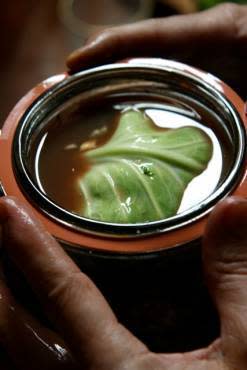Timothy Bartling, Fanatic Fermenter

Fermenting cabbage
Local chef, wild foods gatherer, and traveler Timothy Bartling gets really excited when he finds something new to ferment in his kitchen. Using water, salt, and wild-roaming yeasts and micro-organisms from the atmosphere, Bartling is always on to a new experiment. He admits to getting carried away—his small downtown apartment runneth over with jars of every size, each one bubbling with mysterious mixtures and potions.
On May 8 at Wild Goose Farm on Sauvie Island, Bartling will conduct his fermentation workshop. The class will cover kraut, sour vegetables, kimchi, sourdoughs, hot sauces, Indian idli, and drinks such as beet kvass, dairy kefir, and naturally fermented sodas. (Space is limited.)
FIVE QUESTIONS WITH TIMOTHY BARTLING
TG: Natural fermentation seems to be a popular food trend these days. When did you begin to ferment?
TB: I started fermenting cabbage for sauerkraut and kimchee when I was younger. Then, I took a class with Sandor Katz at his place in the hills of middle Tennessee and discovered an entire universe of fermented foods—some things that I already loved but didn’t really know they were fermented, like tempeh and sprouted grains, which ferment through a soaking process, and other entirely new things like natto and koji, which fascinated me from a culinary standpoint and a health driven philosophy. Sandor is the reason so many people are into this fermenting revolution of DIY communities around the country.
TG: What’s your favorite thing to ferment these days?
TB: I love to ferment root vegetables, they are the easiest and require the least amount of time. If I had a cellar, I’d have pots of miso, tempeh, and crocks of kraut. Sodas are also really fun to make at home too.
TG: Do you have any fermenting disasters you want to share?
TB: Disaster, well..it’s sort of impossible to have a disaster because this stuff really doesn’t go wrong. It’s as simple as chucking some vegetables in some salt water and putting a weight on them. However, it’s not always easy to get others to understand that it’s okay to eat what’s growing under half an inch of bizarre-looking mold. My favorite story is of being with Sandor Katz at his test kitchen in Tennessee. We were a few days into the course when it came time to pull his year old kidney bean barley miso from the back room. It was covered with a moldy piece of blackened canvas and when the top came off everyone gasped and literally jumped back from the table at the sight of the nastiest looking mold growing on the surface of the miso. Sandor stuck his hand in and scooped away the mold, and without missing a beat, stuck the other clean hand in and plopped a big wad of the miso in his mouth and jumped with joy at how good it tasted. We all then did the same. Goodness grows under the mold. I’ve never heard of anyone getting sick or dying from eating fermented vegetables!
TG: Have you come up with anything Sandor Katz has not?
TB: Not really, it’s a big world out there, but wild ferments have been around since cave man, so not a lot of new things to discover.
TG: I suppose one could say fermenting foods, whether it’s sourdough for bread or cabbage for kraut, is somewhat addictive. Do you agree?
TB: Yes, to have a dozen jars and crocks around my kitchen fermenting makes me very happy. It’s an incredible process to watch the food go through the process of being broken down by lactobacilli. I do things in pint-sized mason jars all the way up to an old 12 gallon crock that I bought at a yard sale. It’s entirely possible and easy to have a few small jars always going with whatever might be in season, though by default I tend to ferment things in the cooler autumn, winter, spring months.




